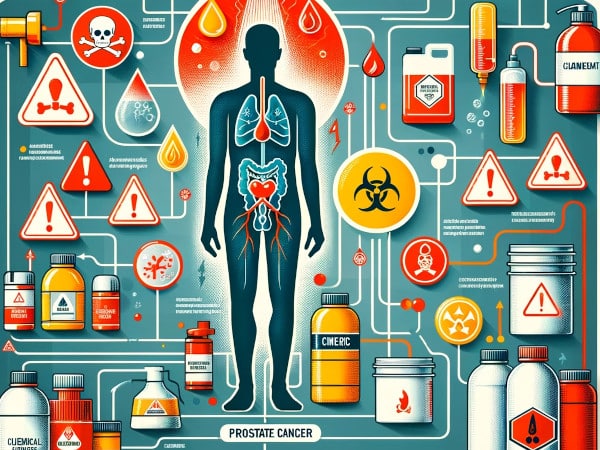Introduction

The link between chemical exposure and prostate cancer is a growing concern in medical research. Various chemicals in the environment, workplace, and even in homes may increase the risk of developing prostate cancer. This page explores the types of chemicals associated with this risk and the mechanisms through which they affect prostate health.
Types of Chemicals Linked to Prostate Cancer
- Pesticides and Herbicides: Studies have shown that exposure to certain pesticides and herbicides, such as glyphosate, can increase the risk of prostate cancer. For instance, a study published in the Journal of Toxicology and Environmental Health (Alavanja et al., 2003) found a significant association between pesticide exposure and increased prostate cancer risk among farmers.
- Industrial Chemicals: Substances like polychlorinated biphenyls (PCBs) and dioxins, often found in industrial settings, have been linked to a higher risk of prostate cancer. Research in the Environmental Health Perspectives (Charles et al., 2003) indicated that workers exposed to PCBs had a higher incidence of prostate cancer.
- Heavy Metals: Exposure to heavy metals like cadmium, often found in batteries and paints, is also associated with an increased risk of prostate cancer. A study in the Prostate journal (Sawada et al., 2010) reported that cadmium exposure could lead to prostate cell proliferation.
- Foods and Food Supplements: In addition to these environmental and industrial chemicals, certain foods and food supplements may also pose a risk.
- Butylated Hydroxyanisole (BHA) and Butylated Hydroxytoluene (BHT): These are synthetic antioxidants used as preservatives in food and cosmetics. While they are considered safe by the U.S. FDA, the EU classifies BHA as a possible human carcinogen and restricts its use. BHT has also raised health concerns due to its potential to act as an endocrine disruptor.
- Potassium Bromate: Used in bread-making to improve dough and increase volume. It’s banned in the EU due to its potential carcinogenic effects but still used in the U.S. despite concerns about its safety.
- Azodicarbonamide (ADA): A chemical used as a dough conditioner and flour bleaching agent. Banned in the EU and Australia due to concerns about its potential to cause asthma and other health issues, but still permitted in the U.S.
- Bovine Growth Hormones (rBGH and rBST): Hormones used to increase milk production in dairy cows. Banned in the EU due to animal welfare concerns and potential health risks to humans, including a possible increase in cancer risk.
- Genetically Modified Organisms (GMOs): The EU has strict regulations and labeling requirements for GMOs, citing concerns about their long-term effects on health and the environment. In contrast, the U.S. has more lenient regulations and does not require labeling.
- Artificial Food Dyes: Some artificial dyes used in the U.S. are banned in the EU due to concerns about their potential links to hyperactivity in children and other health issues.
- Olestra (or Olean): A fat substitute in some snack foods. It is banned in the EU and Canada due to gastrointestinal side effects and potential nutrient absorption issues.
- Phosphates: Widely used in American food products, but their excessive consumption is linked to heart and kidney problems. The EU has stricter regulations on phosphate additives.
- Farm Animal Antibiotics: The EU has stricter regulations on the use of antibiotics in farm animals, aiming to reduce antibiotic resistance. The U.S. uses antibiotics more liberally, raising concerns about the impact on human health.
- High Fructose Corn Syrup (HFCS): More commonly used in the U.S. than in the EU. There are concerns about its role in obesity and diabetes, as well as its potential impact on liver health.
Mechanisms of Risk
Chemicals can affect prostate health through various mechanisms:
- Hormonal Disruption: Many chemicals act as endocrine disruptors, altering hormonal balance and potentially stimulating cancer cell growth.
- DNA Damage: Some chemicals can cause genetic mutations, leading to uncontrolled cell growth.
- Inflammation: Chronic exposure to certain chemicals can lead to inflammation, a known risk factor for cancer.
Reducing Exposure and Risk
- Awareness and Avoidance: Being aware of the sources of harmful chemicals and taking steps to avoid or minimize exposure is crucial.
- Workplace Safety: Employers and employees should ensure proper safety measures are in place when working with hazardous chemicals.
- Regular Screening: Men with a history of chemical exposure should consider regular prostate screenings for early detection.
Conclusion
Understanding the link between chemical exposure and prostate cancer is essential for prevention and early detection. By being aware of the risks and taking proactive steps to reduce exposure, men can significantly impact their prostate health.
References:
- Alavanja, M.C., et al. (2003). Journal of Toxicology and Environmental Health.
- Charles, L.E., et al. (2003). Environmental Health Perspectives.
- Sawada, N., et al. (2010). Prostate.